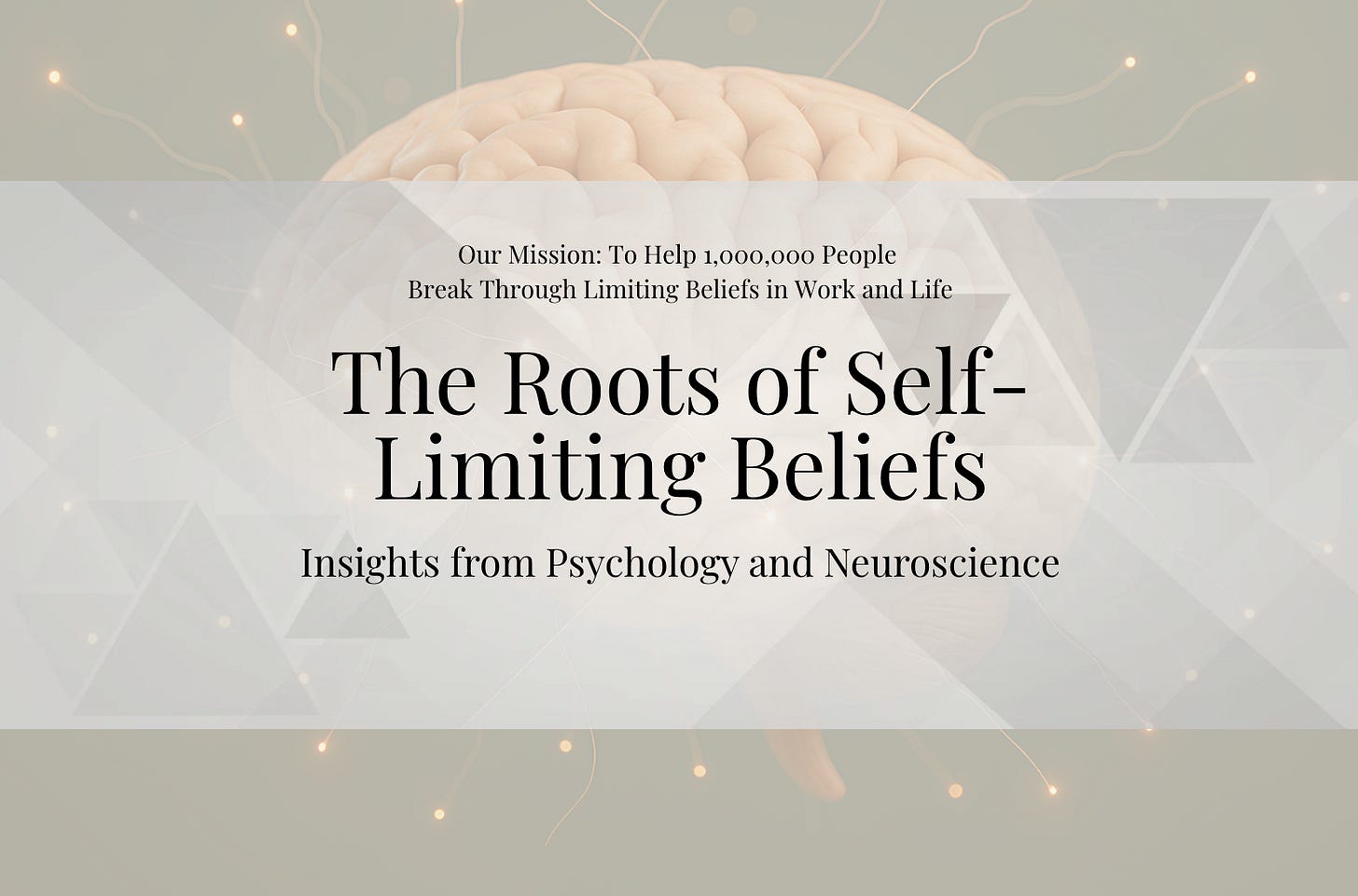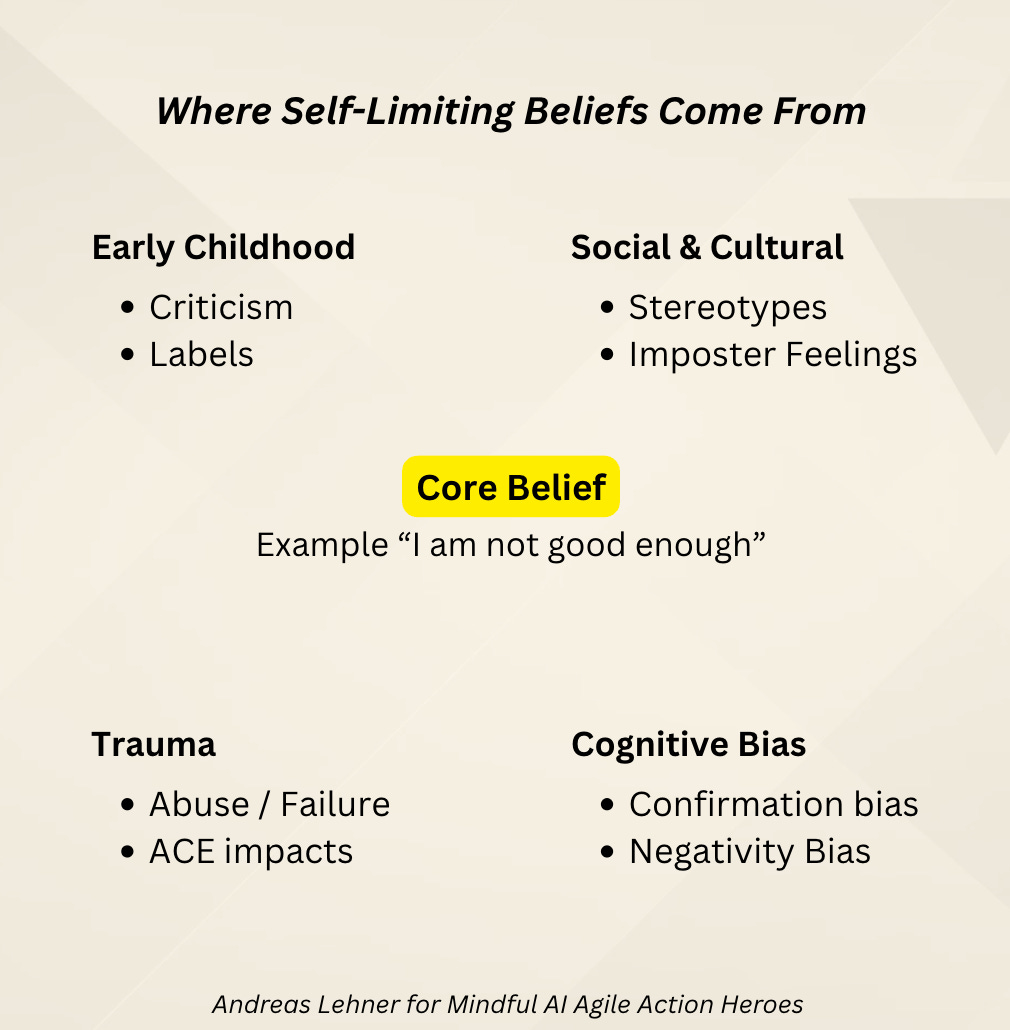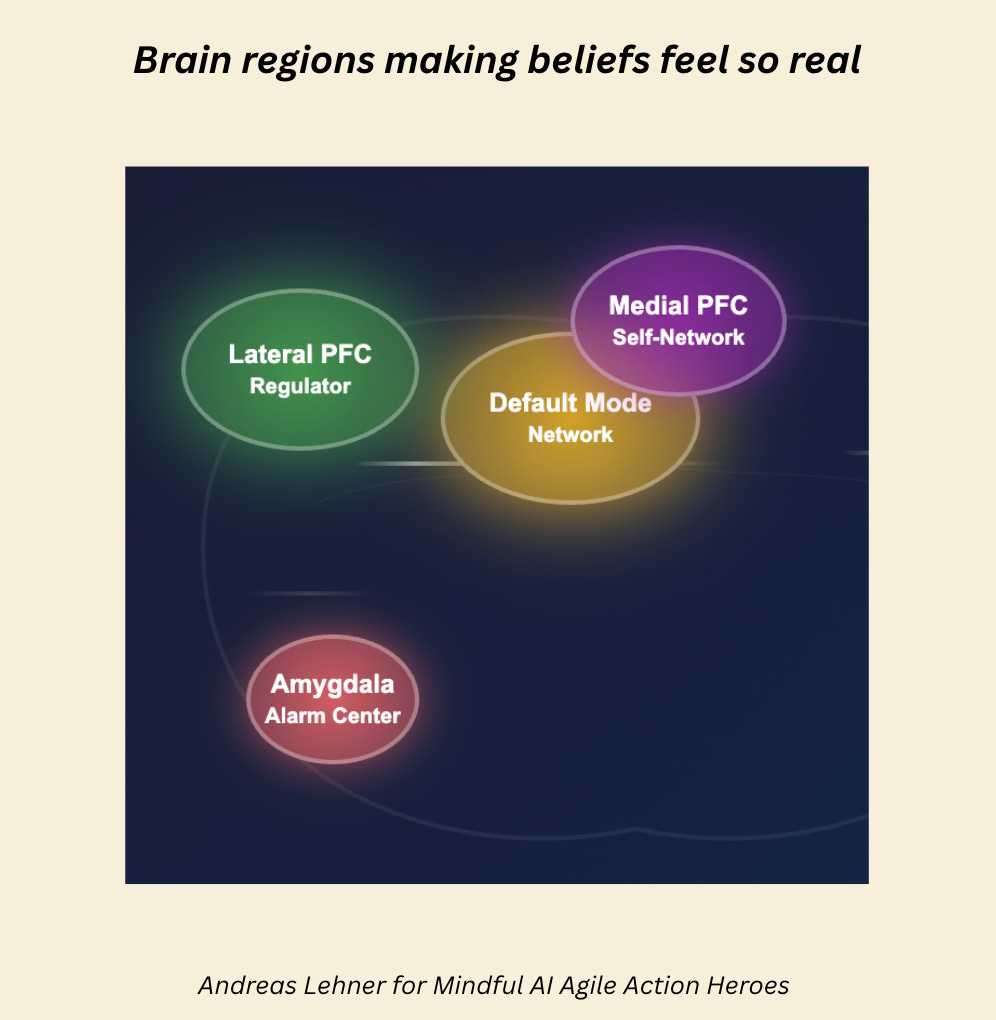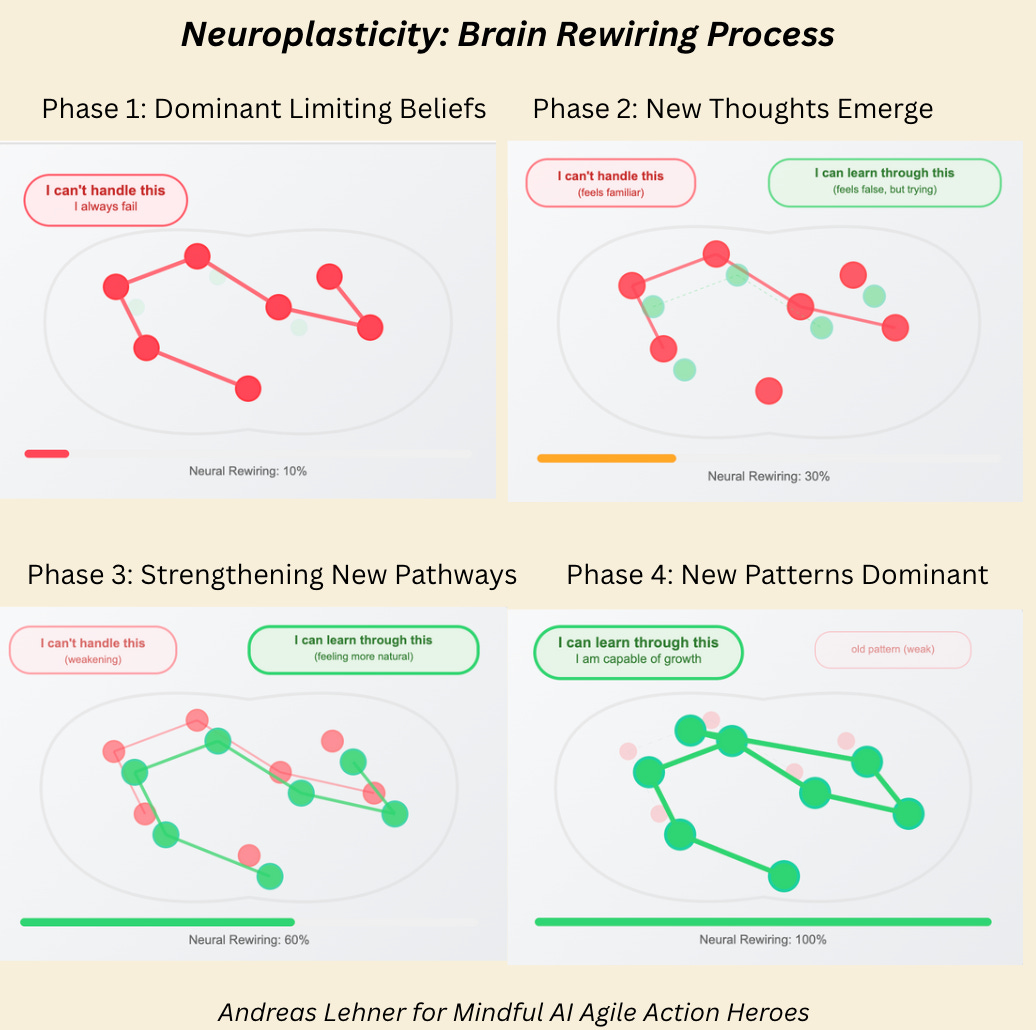The Roots of Self-Limiting Beliefs: Insights from Psychology and Neuroscience
Uncover the hidden psychology and brain science behind self-limiting beliefs—and learn why even the most capable professionals hold themselves back.
Purpose and Scope of This Research
This article explores the psychology and neuroscience of self-limiting beliefs. The foundation comes from peer-reviewed studies, supported by insights from popular science books, expert blogs, and commentaries.
The aim is to explain what self-limiting beliefs are, how they take root, and why they can feel so convincing—even when they’re not true. The focus is both scientific and practical: showing how these beliefs shape daily choices, influence ambition, and quietly limit potential in professional and personal life.
Let’s dive in.
The Hidden Impact of Self-Limiting Beliefs
Self-limiting beliefs are the inner scripts that whisper doubts when opportunities arise—statements like “I’m not smart enough to lead this project” or “I don’t deserve success.” They are not facts, but powerful stories we tell ourselves.
Most of the time, they operate below the surface, subtly steering decisions and behaviors. In the workplace, they can chip away at confidence: a capable person might avoid speaking up in a meeting or turn down a promotion because an inner voice insists, “you can’t.”
The cost is real. A 2019 study found that people who strongly held self-limiting beliefs had lower motivation and struggled to reach long-term goals, especially if those beliefs were reinforced early in life. In short, beliefs act like invisible blueprints: if you see yourself as incapable, your actions often follow that script.
This article unpacks the science behind these patterns—how they form, why they stick, and what happens in the brain when self-doubt takes over.
Defining Self-Limiting Beliefs: Core Patterns of Negative Self-Perception
At their core, self-limiting beliefs are deeply held negative convictions about one’s abilities, worth, or potential. They often sound like:
“I’m not good enough.”
“People like me never succeed.”
“I can’t change at my age.”
These beliefs aren’t innate truths. They are learned thought patterns that become ingrained over time—mental “programming” that interprets every challenge or opportunity through a narrow, negative lens.
For example: someone convinced “I’m not leadership material” might avoid promotions or downplay their ideas. By never testing the belief, they end up reinforcing it.
In psychology, these convictions are called core beliefs or schemas—the deep assumptions we carry about ourselves (e.g. “I am unlovable,” “I am incompetent”). Carol Dweck’s concept of a fixed mindset is a classic example: the belief that intelligence or talent is fixed and unchangeable. This mindset discourages effort, challenge, and resilience—acting as a self-fulfilling prophecy.
By contrast, a growth mindset—believing abilities can be developed—promotes persistence and improvement. It shows how beliefs shape reality: if we believe success is possible, we’re more likely to try.
How Self-Limiting Beliefs Form: Childhood, Culture, and Experience
Self-limiting beliefs don’t appear out of nowhere. They form through experience and reinforcement over time. Four main factors play a role:
1. Early Childhood Conditioning
Children absorb messages like sponges. Criticism, labels, or even protective warnings can plant the seeds of limiting beliefs.
A child told “don’t get your hopes up” may grow into an adult who avoids ambition to prevent disappointment.
Praise focused only on “being smart” instead of effort may create fear of tasks that risk proving them “not smart.”
These external voices become internalized as an “inner narrator” that echoes early judgments.
2. Social and Cultural Influences
Beliefs are also shaped by cultural scripts and stereotypes.
A girl discouraged from science might conclude “people like me just aren’t good at math.”
Underrepresented groups in leadership often experience impostor syndrome—the belief of being a fraud despite evidence of competence.
Such messages, absorbed subconsciously, feel normal and hard to challenge—even when unjust or outdated.
3. Trauma and Negative Experiences
Painful experiences, especially in childhood, can imprint lasting negative beliefs. Abuse, neglect, or repeated failure often create “negative cognitions” such as “I am broken” or “I am not worthy of love.”
The landmark Adverse Childhood Experiences (ACE) study showed that trauma correlates with diminished self-worth and many long-term struggles. When faced with overwhelming hurt, the brain often overgeneralizes: concluding “something is wrong with me” as a way to make sense of pain.
4. Cognitive Biases and Belief Perseverance
Once formed, beliefs resist change. The mind clings to them through biases:
Belief perseverance: holding on even when evidence disproves them.
Confirmation bias: noticing only what supports the belief and ignoring the rest.
Negativity bias: remembering criticism far longer than praise.
For example, someone who believes “I’m not smart enough” may dismiss success as luck but dwell on mistakes as proof. Over time, this selective filtering cements the belief.
🔑 Takeaway: Self-limiting beliefs are learned early, reinforced by society and experience, and protected by the brain’s own biases. Left unchecked, they become the silent rules we live by.
The Brain Science of Self-Limiting Beliefs: Why They Feel So Real
Neuroscience helps explain why these beliefs form easily and feel so emotionally true. Three key mechanisms are at play:
1. The Brain’s Negativity Bias
The brain prioritizes threats over positives. The amygdala—the alarm center—fires rapidly at criticism or failure, storing these experiences strongly. Compliments, by contrast, fade unless we consciously hold onto them.
Result: a single harsh remark can outweigh a dozen kind ones, planting the seed of a belief like “I’m not good enough.”
2. Subconscious Programming and Habit Loops
Up to 95% of thought and behavior is subconscious. Repeated doubts carve neural pathways, making them automatic.
This is known as long-term potentiation: “neurons that fire together, wire together.” Once established, these belief-loops pop up like reflexes—even when logic says otherwise. Brain scans show the default mode network cycles through these self-beliefs in the background, reinforcing them without effort.
3. Self-Beliefs and the Brain’s Self-Network
When we think about ourselves, the medial prefrontal cortex (mPFC) and related regions activate. In people with harsh self-beliefs, these areas light up strongly when faced with negative self-statements. The amygdala joins in, making the belief feel emotionally “true.”
Studies show that those prone to anxiety or depression register criticism intensely but barely notice praise. Their brains have been tuned to accept negative self-views as default. Encouragingly, reframing exercises and therapy activate the lateral prefrontal cortex, which regulates emotion and helps rewrite the self-story.
🔑 Takeaway: The brain makes self-limiting beliefs sticky. Negativity is fast-tracked into memory, subconscious loops automate them, and the self-network validates them emotionally.
Rewiring the Brain: How Neuroplasticity Challenges Limiting Beliefs
The good news: the brain can change. Neuroplasticity means it can form new connections and weaken old ones at any age.
When you deliberately practice a new thought—like replacing “I can’t handle this” with “I can learn through this challenge”—it feels false at first. But with repetition and emotional engagement, new circuits strengthen while old ones weaken.
Techniques like visualization, affirmations, mindfulness, or cognitive-behavioral therapy harness this plasticity. Brain-scan studies show measurable changes when people reframe negative self-beliefs: the rational prefrontal regions step in, calming the amygdala and updating self-concept.
🔑 Takeaway: Limiting beliefs are not permanent. The same brain that once learned them can unlearn them—rewiring toward more balanced, empowering patterns.
Watch this interactive visualisation to learn how learning and unlearning works:
https://claude.ai/public/artifacts/12815c9f-6cef-4f44-aed1-4c712a718b3b
Conclusion: From Inner Narratives to Scientific Understanding
Self-limiting beliefs are stories the mind constructs to protect us from pain—but they also shield us from growth. Psychology shows they are learned in childhood, reinforced by culture, and sustained by biases. Neuroscience shows why they’re sticky: the brain prioritizes negative experiences, automates thought loops, and validates them emotionally.
The encouraging truth is that beliefs are malleable. Through awareness, practice, and sometimes professional guidance, people can rewire the brain’s circuits. Change is rarely instant, but consistent effort creates new stories to live by.
As one therapist described: the inner critic is just a storyteller—and storytellers can learn to tell new stories.
Sources:
Connors, M. H., & Halligan, P. W. (2022). Revealing the Cognitive Neuroscience of Belief. Frontiers in Behavioral Neuroscience, 16, 926742. (Open-access)
Nutrunity (O. Sanchez, 2023). Rewire Your Mind: How To Overcome Limiting Beliefs And Reclaim Your Power. [Blog post with scientific references]
HealthCentral (M. Jaworski, 2020). The Negativity Bias: Why the Bad Stuff Sticks. [Article interviewing psychologists]
Psychology Today (R. S. Gornto, 2025). Overcoming Self-Limiting Beliefs. [Therapist’s commentary]
HIGH5 Test (2024). What is a Fixed Mindset? [Blog post on Carol Dweck’s research]






Sometimes it's the media and the whole situation around us that makes us believe we're doomed.
A plant cannot grow in the wrong environment no matter how positive or optimistic one might be.
The environment and the circumstances around us have a say.
Yes we can stand up and believe the best, but sometimes if the negative situation persists it is hard to get out. When you have to start from scratch over and over again, somehow you lose your energy. Yes you cling to hope and God ... because faith is the only way out of the dark.
Loved reading this. Amazing how the brain can rewire itself but also how stubborn the old scripts can be. They sneak back in just when you think you’ve outgrown them.